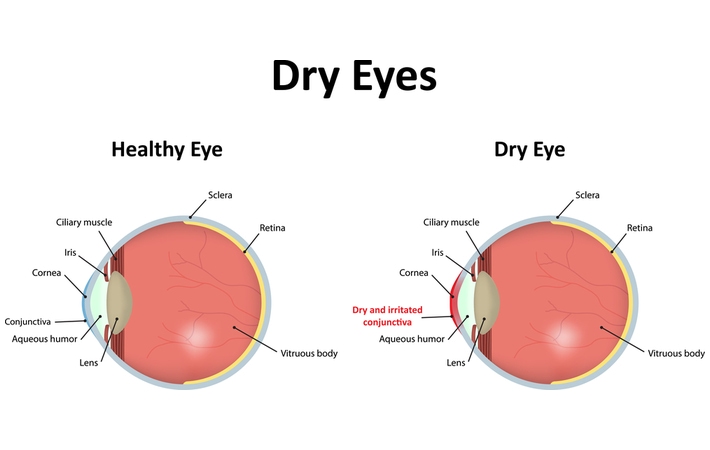Sometimes eye pain and headaches are accompanied by dry eyes. You might notice the symptoms at the same time or they may be staggered. But do dry eyes cause headaches?
While dry eyes do not typically directly cause headaches, they can both exacerbate the symptoms of each other, leading to discomfort, fatigue, and eye pain.
Environmental and lifestyle factors may be affecting both your head and your eyes. Let’s explore what it means to experience dry eye disease and how it relates to headaches and migraines. Regularly scheduled eye exams give your optometrist the chance to assess your vision and provide dry eye therapy solutions to relieve your symptoms.
What is Dry Eye Disease?
Dry eye is an eye condition that can make your eyes feel itchy, irritated, and uncomfortable. This usually occurs because your tears are not being produced sufficiently due to meibomian gland dysfunction (MGD). When the composition of your tears is not normal, it’s difficult for your tears to properly lubricate your eyes. This can leave your eyes feeling dry or as if they are burning.
In Canada, dry eye is a common condition, with over 30% of Canadians experiencing some associated symptoms. The good news is that there are solutions available to help you manage this condition.
Symptoms of Dry Eye
The symptoms of dry eye disease can be constant or only appear at certain moments. The following sensations are indicators that you may have dry eye:
- Eyes feel like they are burning, stinging, or gritty
- Increased sensitivity to light
- Eyes are red
- Inflammation around the eyes
- Stringy discharge coming from the eyes
- Constantly watery eyes
- Blurred vision
- Eye fatigue
Causes of Dry Eye
Environmental factors, lifestyle choices, and other eye conditions can affect the intensity of dry eye symptoms. The following risk factors can influence tear production and contribute to dry eye disease:
- Ageing, especially over the age of 50
- Smokey, windy environments
- Very dry climates
- Eye allergies
- Hormonal changes from menopause or pregnancy
- Certain medical conditions, including Sjogren’s syndrome
- Overexposure to the sun
- Certain medications including antihistamines and antidepressants
- Wearing contact lenses
- Digital eye strain
Connecting Headaches & Dry Eyes
Headaches can be a symptom of several different things wrong with your body. A headache can leave you with a steady discomfort or a throbbing pain in your head. Some of the reasons that you may be prone to headaches include:
- Emotional stress
- Excessive medication use
- Eye, neck or back strain caused by poor posture
- Lighting
- Alcohol consumption
- Changes in eating or sleeping patterns
- Depression
- Noise
- Weather changes
A migraine is a neurological disease often accompanied by an intense pulsing headache. Over 2.5 million Canadians have been diagnosed with migraines. People often identify the feeling of dry eyes among the symptoms of a migraine headache.
How are Dry Eyes and Headaches Related?
Dry eye has yet to be proven as a cause of headaches, but there is a relationship between headaches and dry eye disease. Studies show that being diagnosed with migraines increases your chances of having symptoms of dry eye by about 20%. The symptoms of dry eye may become more obvious when migraines are present.
People who are prone to migraines might be negatively affected by abnormal structural qualities of their eyes. But both the head and the eyes can display symptoms caused by other things. Some medications can lead to symptoms of both dry eyes and migraines.
People who suffer from migraines can experience increased light sensitivity. But there are some treatments to help manage dry eye and reduce the symptoms associated with it.

Dry Eye Treatment
There are several ways you can diminish dry eye symptoms and help your eyes feel refreshed. While dry eye treatment may not stop all of your headaches, it can help manage dry eye signs that might contribute to the discomfort of headaches.
If you are someone who spends a lot of time staring at digital screens, you may want to try blue light blocking lenses. These lenses limit the amount of blue light you’re exposed to during long sessions on a computer. The benefits can include better sleep and less eye fatigue.
Intense Pulsed Light Treatment
One of the ways to manage dry eye symptoms caused by inflammation is with intense pulsed light treatment (IPL). IPL improves the symptoms for people with dry eyes by using light energy to improve the effects of meibomian gland dysfunction (MGD). This treatment has been safely used for decades in dermatology and is considered a safe, effective practice.
A consultation with your optometrist can let you know if you qualify for IPL dry eye treatment.
Radiofrequency Therapy
Another modern solution for dry eye symptoms is radiofrequency therapy (RF). RF is an effective eyelid heat treatment that stimulates gland production for healthy tears. RF has been used safely in the medical world for over 20 years.
You can address the symptoms of MGD and the uncomfortable sensation of dry eyes with radiofrequency treatments. Book an appointment to discuss this solution with your optometrist.
Help Your Headaches
Reducing headaches and dry eyes is an ongoing process. Dry eyes do not cause headaches but it’s common to experience both at the same time. Treating dry eye disease may mitigate some of the symptoms that make a migraine or headache uncomfortable.If your eyes often feel dry and uncomfortable, it’s best to book an appointment with our optometrists. Helping you see clearly and comfortably is one of the ways you can manage migraines and headaches.



